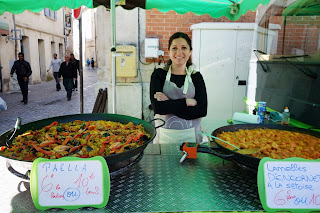Beaucaire is on one side of the Rhône, Tarascon on the other. We had thought to start the Canal du Rhône à Sète from Beaucaire but once there were advised against it, since the projected bike path wasn't really a go-er yet. We went to see the proposed start and agreed with the tourist office. We didn't have the time-frame to fight nature, as we had to be in Sète the following day, to catch Armelle and Sam before they went to Italy for the weekend. (You can, from there. Easily!)
The Tourist Office regretted there was no camping ground, so we settled for an interesting hotel which had been a college in 1635, when there weren't a lot of colleges about. Marvellous marble staircases and statues. The teachers, members of the clergy, did not escape the terror of 1793 and the building was taken by the state. By no means all of the buildings survived the following two centuries but it was an interesting place to stay, with a history typical of many other places.
In the afternoon, we biked over the bridge to Tarascon. First notice we see is to the camping ground. But this, of course, is not Beaucaire's camping ground. It is Tarascon's. And what do we see next? The Tarascon tourist office, which is able to give us information about their side of the river. However, this separation goes way back in history, so I guess it's not going to change soon. There are two castles, one in Beaucaire and the other in Tarascon, facing each other over the Rhône, which formed a boundary between one ruler's lands and another's, (the ruler depending on the era.)
The next morning's market changed the atmosphere completely. Colourful stalls along the side of the canal, and in the centre of town produce of all sorts. We picked up two more electrical outlet adapters for a couple of euros each. In its heyday, Beaucaire had a ten-day fair, where the town earned enough to keep it for a year (as much as the port of Marseilles, they say), so the commerce generated by the canal boats and markets may well help the coffers. The day was fine, the town was humming and we thought yes, we could return here some time.
The Tourist Office regretted there was no camping ground, so we settled for an interesting hotel which had been a college in 1635, when there weren't a lot of colleges about. Marvellous marble staircases and statues. The teachers, members of the clergy, did not escape the terror of 1793 and the building was taken by the state. By no means all of the buildings survived the following two centuries but it was an interesting place to stay, with a history typical of many other places.
In the afternoon, we biked over the bridge to Tarascon. First notice we see is to the camping ground. But this, of course, is not Beaucaire's camping ground. It is Tarascon's. And what do we see next? The Tarascon tourist office, which is able to give us information about their side of the river. However, this separation goes way back in history, so I guess it's not going to change soon. There are two castles, one in Beaucaire and the other in Tarascon, facing each other over the Rhône, which formed a boundary between one ruler's lands and another's, (the ruler depending on the era.)
The next morning's market changed the atmosphere completely. Colourful stalls along the side of the canal, and in the centre of town produce of all sorts. We picked up two more electrical outlet adapters for a couple of euros each. In its heyday, Beaucaire had a ten-day fair, where the town earned enough to keep it for a year (as much as the port of Marseilles, they say), so the commerce generated by the canal boats and markets may well help the coffers. The day was fine, the town was humming and we thought yes, we could return here some time.






No comments:
Post a Comment